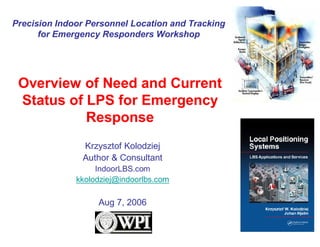
Indoor LBS Kolodziej
- 1. Precision Indoor Personnel Location and Tracking for Emergency Responders Workshop Overview of Need and Current Status of LPS for Emergency Response Krzysztof Kolodziej Author & Consultant IndoorLBS.com kkolodziej@indoorlbs.com Aug 7, 2006
- 2. About the Book – Summary • A 4 year collaboration with academia, research, and industry – E.g., MIT Cricket, Microsoft Research, Intel Place Lab, Rosum, etc • Chapter 4: Sensor Systems for Indoor Position Computation – Complimentary and alternative positioning technologies to GPS – Sensors types: Ultrasound, Ultrawideband, TV, IR, Bluetooth, 802.11 (Wi-Fi), RFID, ZigBee, Video, Inertial, Electromagnetic, Optical – Indoor signal propagation characteristics, multipath, algorithms – Ad-hoc-based vs infrastructure-based systems • Chapter 5: Indoor Location Awareness and Navigation – Indoor map and sensors data – 2D vs 3D – Spatial reference systems (absolute | relative) – Path planning algorithms – Geocoding • Chapter 8: Service Deployment – Using a Wi-Fi network (Site survey, positioning models, radio map training, system configuration)
- 3. About the Book – Classification of LPS
- 4. About the Book -- Applications and Accuracy Requirements Indoor positioning required
- 5. About the Book -- Applications and Accuracy Requirements Indoor positioning required
- 6. The Need for LPS – Indoors • 2 million emergency responders in the US – Mission: save lives, while staying alive themselves. • Emerging technologies are critical for meeting the USFA’s goal: reduce firefighter fatalities by 25% in the next five years. • Existing technology allows first responders to monitor their own safety – E.g., Personal Alert Safety System (PASS) and Heads-Up-Display (HUD) units, and to send and receive messages from incident command. • However, reoccurring failures and user error have led to firefighter fatalities and injuries: – Fatalities: 117 in 2004 (USFA) – Fireground – 37,976 injuries • Total injuries: 80,800 in 2004 (NFPA)
- 9. DHS Advanced 3D Locator System • A lack of status, condition, location, task, resource, threat, and exit accessibility information, or inability to convey this information among emergency responders, strike teams, and incident command can result in civilian and responder casualties. – Firefighting is making a lot of decisions on little information. • Users: – Federal, State, Local and Tribal incident responders and managers – DHS / Emergency Preparedness / Federal Emergency Management Agency (FEMA) – All lead and supporting Federal agencies of the National Response Plan – Law Enforcement agencies – Fire Departments
- 10. DHS Advanced 3D Locator System Some of the required performance measures: 1. Transmit information inside and outside to on-site and off-site personnel a. No matter the type of building or structural state b. Within 30-100m for tactical (e.g., incident command) 2. Self-initializing, self-calibrating, self-adjusting and self- diagnostic. 3. Base station software must have: a. 3-6m positioning accuracy b. Advanced scene visualization i. 3D location capabilities ii. Wire-frame like view of the building structure with the position of each responder indicated iii. identify, group, and categorize responders as desired 4. GIS (optional)
- 11. The Need for LPS – Indoors (Civilians) • Plus, 4,000 civilian fatalities! (USFA) • 184 million U.S. wireless subscribers (Jupiter Research, 2005 projection) • > 30% of 911 calls in the US originate from mobile phones--a number expected to soon outpace 911 wire- line calls (NENA) • 62% of all calls in the US are made from cell phones (CTIA) • People spend most of their time indoors
- 12. Network Reliability and Interoperability (NRIC) • FCC has called upon NRIC to present recommendations to clarify issues surrounding wireless location accuracy requirements. • Stakeholders: wireless industry, the Public Safety community, E911 industry • Efforts within the Emergency Services Interconnection Forum (ESIF), are critical to the implementation of NRIC’s recommendations. • Indoor versus Outdoor Location Testing Recommendation: – All parties agreed to 5% of test calls must be conducted from indoor locations for compliance and maintenance testing. • Testing location accuracy inside permanent structures. • The 5% value was chosen because …. “no data currently exists that defines the actual number of wireless 9-1-1 calls made from indoors and because of practical limitations of location technologies currently deployed.” • The subcommittee also recommends that public safety attempt to track the amount of wireless 911 calls that are made from indoor versus outdoor locations.
- 13. In-Building Wireless Alliance (IBWA) An advocacy for: – Commercial Real Estate – Wireless – Public safety uses of in-building wireless solutions • Indoor location services for public safety and asset tracking • DHS is concerned about buildings • The FCC Commissioner was educated 2yrs ago about the ability to do 3D positioning indoors
- 14. Precision Indoor Personnel Location and Tracking for Emergency Responders Workshop Current Status of LPS for Emergency Response -- Survey --
- 15. Survey Rescue | Tactical Deployment Range Position Calculation Position Method Signal Used Transmitter Receiver Accuracy (outdoor and indoor) Cost
- 16. Precision Indoor Personnel Location and Tracking for Emergency Responders Workshop Survey results will be posted online at indoorLBS.com
- 17. Ending Remarks Get involved in OGC’s OWS-4 Testbed: CAD / GIS / BIM group Sensor Web group OpenLS group
- 18. Thank You Krzysztof Kolodziej IndoorLBS.com kkolodziej@indoorlbs.com